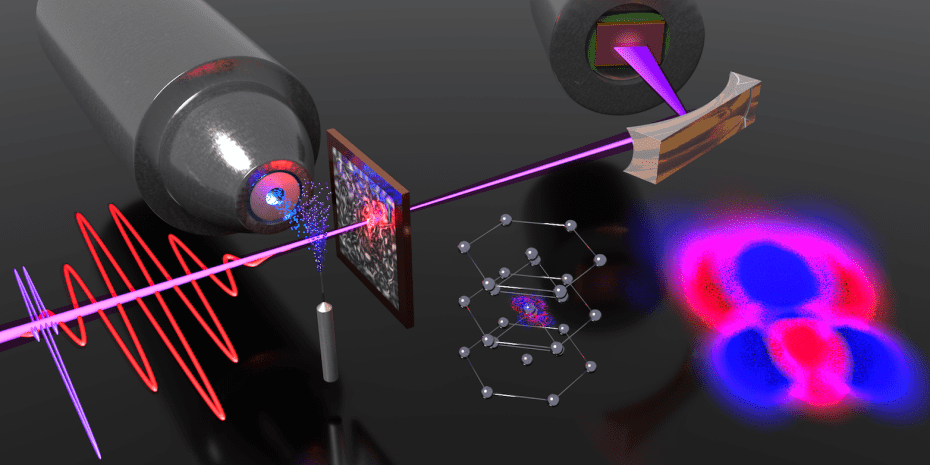Aug 6 2019
Physicists at ETH have measured how electrons in so-called transition metals become redistributed within a fraction of an optical oscillation cycle. They witnessed the electrons becoming concentrated around the metal atoms in less than a femtosecond.
 Illustration of the setup and the interaction of a short laser pulse (red oscillating line) with the lattice of titanium atoms (center, lower half of figure). The red and blue structures represent the redistribution of the electron density in the vicinity of a titanium atom. A close-up of this change in density is shown on the bottom right. (Image credit: ETH Zurich/D-PHYS Ultrafast Laser Physics group)
Illustration of the setup and the interaction of a short laser pulse (red oscillating line) with the lattice of titanium atoms (center, lower half of figure). The red and blue structures represent the redistribution of the electron density in the vicinity of a titanium atom. A close-up of this change in density is shown on the bottom right. (Image credit: ETH Zurich/D-PHYS Ultrafast Laser Physics group)
This regrouping might affect crucial macroscopic properties of these compounds, such as magnetization, electrical conductivity, or optical characteristics. The work, thus, proposes a route to regulating these properties on very rapid time scales.
The electron distribution in transition metals, which signify a large part of the periodic table of chemical elements, is accountable for a number of their stimulating properties used in applications. The magnetic properties of a few of the members of this group of materials are, for instance, manipulated for data storage, while others display exceptional electrical conductivity.
Transition metals also play a critical role in novel materials with highly exotic behavior that stems from powerful interactions between the electrons. Such materials are favorable candidates for a broad range of future applications.
During their experiment, Mikhail Volkov and colleagues in the Ultrafast Laser Physics group of Prof. Ursula Keller thin foils of the transition metals titanium and zirconium were exposed to short laser pulses. They noticed the redistribution of the electrons by recording the ensuing variations in optical properties of the metals in the extreme ultraviolet (XUV) domain. So as to be able to monitor the induced variations with adequate temporal resolution, XUV pulses with a duration of just a few hundred attoseconds (10-18 s) were applied in the measurement.
By relating the experimental results with theoretical models, created by the group of Prof. Angel Rubio at the Max Planck Institute for the Structure and Dynamics of Matter in Hamburg, the scientists determined that the change taking place in less than a femtosecond (10-15 s) is because of an alteration of the electron localization in the area of the metal atoms.
The theory also estimates that in transition metals with more strongly filled outer electron shells an opposite motion—namely, delocalization of the electrons—is to be anticipated.
The results of the research were reported in a paper published recently in Nature Physics.
Ultrafast control of material properties
The electron distribution establishes the microscopic electric fields within a material, which do not only hold a solid together but also to a large degree establish its macroscopic properties. By varying the distribution of electrons, one can thus direct the features of a material as well. The experiment of Volkov et al. shows that this is possible on time scales that are significantly shorter than the oscillation cycle of visible light (about two femtoseconds).
Even more crucial is the discovery that the time scales are a lot shorter than the so-called thermalization time, which is the time frame for the electrons to wash out the effects of external control of the electron distribution via collisions between themselves and with the crystal lattice.
Initial surprise
To begin with, it was a revelation that the laser pulse would result in better electron localization in zirconium and titanium. A basic trend in nature is that if bound electrons are offered with more energy, they will become less localized. The theoretical examination, which backs the experimental observations, revealed that the increased localization of the electron density is a net effect ensuing from the stronger filling of the characteristic partially filled d-orbitals of the transition-metal atoms.
For transition metals that possess d-orbitals which are already more than half filled (to be exact, elements found closer to the right side of the periodic table), the net effect is to the opposite and matches to a delocalization of the electronic density.
Towards faster electronic components
While the result currently testified is of fundamental nature, the experiments show the likelihood of a very quick modification of material properties. Such variations are used in electronics and opto-electronics for the transmission of data or the processing of electronic signals.
While existing components process signal streams with frequencies in the gigahertz (109 Hz) range, the results of Volkov and co-workers specify the possibility of signal processing at petahertz frequencies (1015 Hz). These rather critical findings might thus inform the progress of the next generations of ever-faster components, and through this incidentally, find their way into man’s daily life.